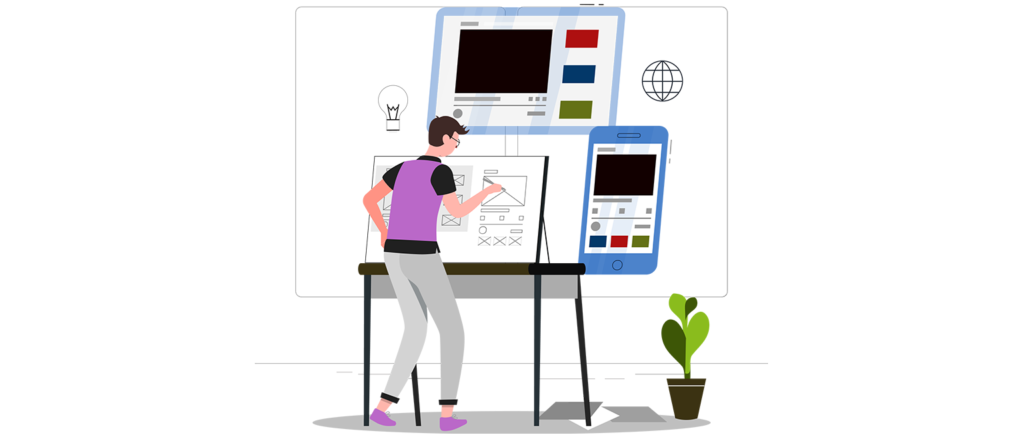The Need for Interactive Website Design

Table of Contents
Having a website nowadays is like having a storefront on a busy street. But having a store isn’t enough; it needs to be appealing and draw people in. Likewise, a website needs to do more than just exist – it should engage and interact with visitors in a way that keeps them interested and wanting to explore further.
Interactive website design is the secret ingredient that transforms a regular website into an engaging destination. It’s not just about providing information; it’s about creating an experience that visitors actively participate in. Imagine your website as a place where visitors don’t just passively browse; instead, they engage, click, explore, and have fun.
When a website is interactive, it’s like opening a door to an exciting story. Visitors don’t just read; they get involved. Whether it's through quizzes, interactive videos, or personalized content, these elements aren’t just for show – they're there to make visitors feel curious and entertained.
The interactive design turns a casual visitor into an engaged participant. It's about making your website more than a static page; it's about transforming it into a vibrant space where visitors feel welcomed, intrigued, and inclined to stay longer.
So, interactive website design is about creating an online environment that invites people to interact, explore, and feel like they're part of something dynamic. It's not just about having a website; it's about making it a place that people want to visit and revisit, time and again.
This evolution from plain, static websites to engaging, interactive ones is like turning a closed door into an open invitation. It's about transforming an online presence into an interactive experience that’s not just about being there but engaging and enjoyable for everyone who comes across it.
Benefits of Interactive Website Design
Improved User Engagement
Interactive websites excel in captivating visitors by delivering an immersive and interactive experience that goes beyond static content. They employ various engaging elements such as quizzes, polls, dynamic visuals, and interactive storytelling. These elements act as magnets, drawing users into the website's ecosystem and encouraging them to explore further.
The introduction of interactive elements provides visitors with an active role rather than passive consumption, enticing them to spend more time engaging with the site's content. These engaging features are carefully crafted to cater to diverse interests, ensuring that visitors find something intriguing or enjoyable during their exploration.
By providing users with a gamified or participatory experience, interactive websites effectively reduce bounce rates. Visitors are enticed to stay longer, exploring multiple sections or pages as they interact with the site's dynamic features. As a result, prolonged engagement positively impacts the website's metrics and contributes to a more memorable user experience.
Enhanced User Experience
Interactive website design is tailored to enhance the overall user experience through intuitive navigation, engaging content, and personalized interactions. Navigation is streamlined and user-friendly, ensuring visitors can easily find what they’re looking for without frustration. Clear menus, clickable elements, and logical pathways create a seamless journey for users, fostering a sense of ease and satisfaction.
Content on interactive websites isn’t just informative; it’s crafted to engage and resonate with the audience. The incorporation of multimedia elements, interactive storytelling, and personalized content ensures that users feel connected to the website, compelling them to explore deeper.

Moreover, personalized interactions contribute significantly to visitor satisfaction. Whether it’s customized recommendations based on user behavior or interactive tools that cater to individual preferences, these personalized touches make visitors feel valued and understood. This positive user experience contributes to a favorable perception of the brand, fostering trust and loyalty.
Higher Conversion Rates
The emphasis on user engagement and an enhanced experience in interactive website design significantly impacts conversion rates. Engaged visitors who actively interact with the website's features are more likely to convert into leads or customers.
When visitors feel captivated and involved, they are more inclined to take desired actions such as signing up for newsletters, making purchases, or filling out contact forms. The immersive experience provided by interactive elements motivates users to move further along the conversion funnel.
Ultimately, the increased engagement and positive user experience culminate in higher conversion rates. The interactive design not only attracts visitors but also nudges them towards taking meaningful actions, thereby boosting sales and revenue for businesses.
Key Features of Interactive Website Design
Interactive website design involves several key features that contribute to its effectiveness:
Responsive Design
Imagine your website as a superhero that can adapt to any device – whether it's a big computer screen or a tiny phone screen. That's what responsive design does! It's like magic that makes your website look great and work perfectly no matter what gadget people use to visit it.
With responsive design, your website adjusts itself automatically to fit different screens, like how a chameleon changes its colors. This means people can easily read and navigate your website whether they're on a computer, tablet, or phone. It's all about making sure everyone gets the best experience, no matter what device they use.
User-friendly Navigation
Think of navigation as a map for your website. Just like a clear road map helps you find your way, user-friendly navigation makes it easy for visitors to find what they want on your site. It's like having signs and arrows that guide people exactly where they want to go.
User-friendly navigation means making buttons and menus easy to click, with clear labels that tell visitors where each click will take them. When visitors can move around your site without getting lost or confused, it's like giving them a smooth and stress-free journey, making them happy to stay and explore more.
Interactive Elements
Interactive elements are like the fun toys in a playroom that keep visitors entertained and engaged. They include things like moving animations, cool videos, friendly chatbots, or forms that you can fill in. These elements aren’t just for show – they're there to make your website more exciting and memorable.
Animations and videos catch people's attention, making your website more interesting. Chatbots and interactive forms let visitors be part of the action, like having a friendly conversation or playing a game. These interactive bits make people want to spend more time on your site, enjoying the experience and coming back for more.
Want to know more about Fundamental Concepts for UI/UX Design?
Importance of Interactivity in Websites
Establishing Brand Identity
An interactive website acts as a digital ambassador for a brand, shaping its identity and personality. It’s a virtual canvas where a brand paints its story, values, and uniqueness. Through interactive elements like engaging visuals, immersive storytelling, and interactive experiences, a brand can convey its narrative vividly and engagingly.
The interactive nature of the website allows visitors to actively engage and experience the brand rather than passively consuming information. By integrating interactive features that align with the brand's ethos, such as personalized quizzes, interactive tours, or user-generated content sections, brands can create a memorable and authentic digital experience. This fosters a deeper emotional connection with the audience, leaving a lasting impression and reinforcing brand loyalty.
Furthermore, an interactive website enables brands to experiment with creative storytelling methods. Whether it's through interactive timelines, gamified experiences, or interactive product demos, brands can showcase their history, values, and offerings in a captivating and innovative way. This distinctiveness helps the brand stand out in the competitive digital landscape, creating a unique identity that resonates with visitors.
Competing in the Digital Market
In the crowded online marketplace, standing out is a challenge. An interactive website serves as a beacon that draws attention amid the noise. It’s the difference between having a static display and a captivating storefront that compels passersby to stop and explore further.
By offering an interactive and engaging user experience, businesses elevate themselves above the competition. Incorporating interactive elements like dynamic visual storytelling, gamification, or personalized user journeys makes the website not just informative but enjoyable. This positive experience encourages visitors to spend more time on the site, increasing the chances of conversion and repeat visits.
Moreover, an interactive website provides a competitive edge by adapting to changing consumer preferences. Whether through interactive product configurators, virtual tours, or personalized recommendations, businesses can cater to individual needs. This adaptability and personalized approach help in carving a niche in the digital market, setting the brand apart and creating a loyal customer base.
Connecting with the Target Audience
An interactive website serves as a powerful tool for businesses to understand their audience better. By incorporating interactive features that encourage user engagement, businesses gain valuable insights into visitor behavior, preferences, and interests.
Through surveys, polls, or interactive feedback forms, businesses collect data that helps decipher what resonates with their audience. This data becomes the compass that guides strategic decisions, from tailoring content to refining products or services. Understanding the audience's needs and desires allows for a more personalized and targeted approach, leading to increased visitor satisfaction and loyalty.
Furthermore, an interactive website opens avenues for direct communication and engagement. Features like live chats, interactive forums, or personalized recommendations foster a sense of community and belonging. This engagement creates a reciprocal relationship where visitors feel heard and valued, forging a deeper connection with the brand.
Steps to Create an Interactive Website
Creating an interactive website involves several crucial steps:
Define Purpose and Goals
The cornerstone of designing an effective interactive website begins with clearly defining its purpose and establishing specific goals. Understanding why the website exists and what it aims to achieve is crucial in guiding its design and functionality.
Defining the purpose involves identifying the primary objectives the website intends to fulfill. Whether it’s to drive sales, educate visitors, build brand awareness, or facilitate engagement, having a clear understanding of these objectives helps in aligning every design choice and interactive element toward achieving these goals.
Setting specific and measurable goals, such as increasing user engagement, reducing bounce rates, or improving conversion rates, provides a roadmap for the website's design and development. It ensures that every interactive feature and design element contributes directly to fulfilling these objectives, resulting in a purpose-driven and effective interactive website.
Choose Suitable Design Elements
Selecting the right design elements is akin to choosing the right tools for a job. It’s essential to match the interactive design elements with the target audience's preferences and the brand's identity. These elements serve as the building blocks that engage visitors and bring the website’s purpose to life.

Understanding the audience's preferences, behaviors, and demographics is key in selecting suitable interactive design elements. Whether it’s incorporating animations for visual appeal, interactive menus for seamless navigation, quizzes for engagement, or personalized content for a tailored experience, each design element should resonate with the audience and complement the brand’s identity.
Choosing the right design elements isn't just about making the website visually appealing; it’s about enhancing the user experience and achieving the website's defined goals. Every element should serve a purpose, contributing to creating an immersive and engaging experience that aligns with the website's objectives.
Implement User Feedback Mechanisms
An interactive website thrives on interaction, and user feedback mechanisms play a pivotal role in fostering engagement and continual improvement. Incorporating mechanisms such as surveys, comment sections, or feedback forms encourages user participation and provides valuable insights into user preferences, likes, and dislikes.
These feedback mechanisms act as a direct line of communication between the website and its users, inviting them to share their opinions and suggestions. Gathering user feedback helps in identifying areas for improvement, understanding user expectations, and tailoring the website's features and content to better meet their needs.
Utilizing user feedback to make iterative improvements ensures that the website evolves in line with user preferences and changing trends. By actively listening to user opinions and implementing changes based on their feedback, the website becomes more user-centric, resulting in higher satisfaction levels and increased engagement.
Examples of Successful Interactive Website Designs
Several brands have excelled in creating interactive websites. Examples like Nike's interactive shoe customizer, National Geographic's interactive storytelling, and Spotify's personalized playlists showcase the power of interactive design in engaging users.
Tools and Technologies for Creating Interactive Websites
Numerous tools and technologies, such as Adobe XD, Sketch, and JavaScript libraries like React and Vue.js, empower designers and developers to create stunning interactive websites efficiently.
Future Trends in Interactive Website Design
The horizon of interactive website design appears limitless, brimming with innovations poised to redefine user experiences. As technology continues to evolve, several key trends are set to shape the future landscape of interactive web design, ushering in a new era of immersive and engaging online experiences.

Developments in the Integration of Augmented Reality (AR) and Virtual Reality (VR)
The integration of Augmented Reality (AR) and Virtual Reality (VR) technologies is poised to revolutionize the way users interact with websites. AR and VR elements, once limited to specialized applications, are becoming increasingly accessible through web browsers. This shift enables users to engage with websites in entirely new dimensions, offering interactive and lifelike experiences. Imagine trying on clothes virtually before making a purchase or exploring a virtual showroom for real estate properties – these are just glimpses of what AR and VR integration can offer in interactive web design.
AI-Powered Personalization and User-Centric Experiences
Artificial Intelligence (AI) is set to play a pivotal role in creating hyper-personalized user experiences. AI algorithms analyze user behaviors, preferences, and interactions in real-time, enabling websites to adapt dynamically to individual users. From personalized content recommendations and tailored user interfaces to predictive user journeys, AI-driven personalization fosters a deeper level of engagement by delivering precisely what users need and desire. This anticipatory approach enhances user satisfaction and retention, creating a more intuitive and user-centric browsing experience.
Emphasis on Immersive User Experiences and Interactive Storytelling
The future of interactive web design revolves around storytelling that transcends traditional boundaries. Websites will increasingly leverage multimedia elements, interactive graphics, and storytelling techniques to captivate audiences. Imagine websites that offer immersive narratives, allowing users to explore stories interactively, almost like stepping into a digital world. From interactive documentaries to gamified educational experiences, these immersive storytelling methods will redefine how users engage with content, creating more memorable and impactful experiences.
Enhanced Accessibility and Inclusivity
A significant trend shaping the future of interactive web design is a greater focus on accessibility and inclusivity. Websites will prioritize ensuring that interactive elements and experiences are accessible to users with diverse abilities and needs. Designing for inclusivity involves implementing features such as voice-controlled interfaces, screen reader compatibility, and intuitive navigation, ensuring a seamless experience for all users.
Evolution of Interactive microinteractions and Motion Design
Microinteractions and motion design elements will evolve to provide more engaging and delightful user experiences. These small, interactive elements, such as animated buttons, subtle transitions, or interactive hover effects, add a layer of sophistication and interactivity to websites. The future will see a refinement of these micro interactions, enhancing user engagement and making interactions more intuitive and enjoyable.
Wrap Up
As we navigate the digital landscape, the evolution from stagnant online presences to vibrant, interactive platforms mirrors the transition from a closed door to an open invitation. Interactive website design isn’t merely about showcasing; it's about creating an ever-evolving digital universe where visitors aren’t passive spectators but active participants.
Picture your website as a bustling marketplace, teeming with activities and engagement. Its immersive design beckons visitors not just to glance and move on but to explore, engage, and immerse themselves in an experience that feels tailored to their needs and desires. This transformation, akin to a magic show unveiling unexpected wonders, transcends the mundane and elevates the ordinary website into a captivating journey.
Every interactive element, from dynamic visuals to personalized recommendations, contributes to transforming mere visitors into engaged participants. It’s like hosting an enthralling gathering where each individual feels valued, understood, and intrigued by what’s on offer. The result? A vibrant digital ecosystem that feels less like a static webpage and more like a vibrant community hub, bustling with activities and opportunities to connect.
Imagine the website not as a billboard that passersby glance at but as a portal that beckons users into a realm of discovery and engagement. It’s about turning what was once a silent monologue into a dynamic conversation, inviting everyone to participate, contribute, and feel at home.
In this realm of interactive design, the door isn’t just open; it’s an invitation – an invitation for visitors to embark on an interactive journey, discover new realms, and experience a website that’s not just a destination but a dynamic, ever-evolving adventure.



